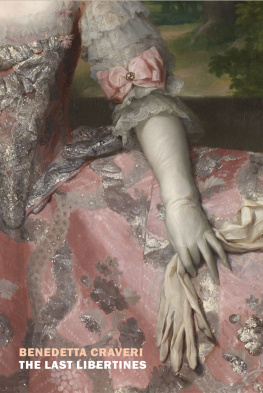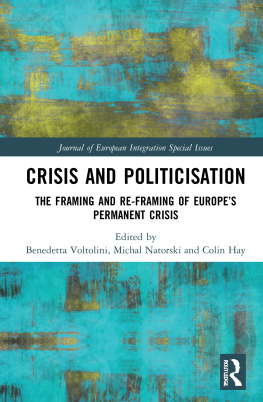Benedetta Craveri - The Last Libertines
Here you can read online Benedetta Craveri - The Last Libertines full text of the book (entire story) in english for free. Download pdf and epub, get meaning, cover and reviews about this ebook. year: 2020, publisher: New York Review Books, genre: Detective and thriller. Description of the work, (preface) as well as reviews are available. Best literature library LitArk.com created for fans of good reading and offers a wide selection of genres:
Romance novel
Science fiction
Adventure
Detective
Science
History
Home and family
Prose
Art
Politics
Computer
Non-fiction
Religion
Business
Children
Humor
Choose a favorite category and find really read worthwhile books. Enjoy immersion in the world of imagination, feel the emotions of the characters or learn something new for yourself, make an fascinating discovery.
- Book:The Last Libertines
- Author:
- Publisher:New York Review Books
- Genre:
- Year:2020
- Rating:4 / 5
- Favourites:Add to favourites
- Your mark:
- 80
- 1
- 2
- 3
- 4
- 5
The Last Libertines: summary, description and annotation
We offer to read an annotation, description, summary or preface (depends on what the author of the book "The Last Libertines" wrote himself). If you haven't found the necessary information about the book — write in the comments, we will try to find it.
The Last Libertines — read online for free the complete book (whole text) full work
Below is the text of the book, divided by pages. System saving the place of the last page read, allows you to conveniently read the book "The Last Libertines" online for free, without having to search again every time where you left off. Put a bookmark, and you can go to the page where you finished reading at any time.
Font size:
Interval:
Bookmark:

The Last Libertines
BENEDETTA CRAVERI
Translated from the Italian by Aaron Kerner
New York Review Books

New York
This is a New York Review Book
published by The New York Review of Books
435 Hudson Street, New York, NY 10014
www.nyrb.com
Copyright 2016 by Adelphi Edizioni, S.p.A, Milan
Translation copyright 2020 by Aaron Kerner
All rights reserved.
Cover image: Anton Raphael Mengs, Maria Carolina of Augsburg-Lorena, Queen of Naples (detail), ca. 1768; Photographic Archive Prado Museum
Cover design: Katy Homans
Library of Congress Cataloging-in-Publication Data
Names: Craveri, Benedetta, 1942 author. | Kerner, Aaron, translator.
Title: The last libertines / Benedetta Craveri ; translated by Aaron Kerner. Other titles: Gli ultimi libertini. English
Description: New York City : New York Review Books, [2020] | Series: New York Review books | Includes bibliographical references and index.
Identifiers: LCCN 2019044362 (print) | LCCN 2019044363 (ebook) | ISBN 9781681373409 ; (hardcover) | ISBN 9781681373416 ; (ebook) Subjects: LCSH: NobilityFranceBiography. | FranceHistoryLouis XVI, 17741793Biography. | FranceHistoryLouis XV, 17151774Biography. Classification: LCC DC137.5.A1 C7313 2020 (print) | LCC DC137.5.A1 (ebook) | DDC 944/.0340922dc23
LC record available at https://lccn.loc.gov/2019044362
LC ebook record available at https://lccn.loc.gov/2019044363
ISBN 978-1-68137-341-6
v1.0
For a complete list of titles, visit www.nyrb.com or write to:
Catalog Requests, NYRB, 435 Hudson Street, New York, NY 10014
for Bernard Minoret
T HIS BOOK TELLS THE STORY of seven aristocrats whose youth coincided with the French monarchys final moment of gracea moment when it seemed to the nations elite that a style of life based on privilege and the spirit of caste might acknowledge the widespread demand for change, and in doing so reconcile itself with Enlightenment ideals of justice, tolerance, and citizenship.
It is always a beautiful thing to be twenty years old, Sainte-Beuve wrote of that generation of nobles. But never was it more so than in 1774, when Louis XVIs ascension to the throne seemed to herald the beginning of a new age, one that would allow these princes of youth (as Louis-Marcelin de Fontanes described them) to advance step by step with their era, in perfect harmony with the world around them.
But could matters really have been so simple? Could the liberal nobility (which welcomed the summoning of the Estates General as an opportunity to put in place those institutional reforms that the country sorely needed, and to establish a constitutional monarchy along English lines) truly have lacked a sense of reality? Did they realize only belatedly, after toying with philosophical theories whose consequences they wholly failed to grasp, just how much they had contributed to their own ruin?
This is not the impression one has when retracing the lives and political choices of the Duc de Lauzun, the Comte and Vicomte de Sgur, the Duc de Brissac, the Comte de Narbonne, the Comte de Vaudreuil, and the Chevalier de Boufflers, the protagonists of this book. In making my selection of precisely these seven from among the many brilliant and representative figures of the era, I was driven, of course, by the romantic character of their exploits and amoursbut also by the keenness with which they experienced this crisis in the civilization of the ancien rgime, of which they themselves were the emblem, all while keeping their gaze fixed on the new world that was in the process of being born. Each of them belonged to the ancient feudal nobility and possessed those prerogatives that their class took the most pride in: dignity, courage, refinement of manners, culture, wit, and the art of pleasing. Aware of their advantages and determined to make themselves felt in the world, they responded with all they had to the demands of a profoundly theatrical society, in which one was obliged to know how to hold ones place at center stage. They were also past masters of the art of seduction, and their many successes with the dames du grand monde did not prevent them from practicing libertinism in its broadest sense. This is why I have called them the last libertineseven if each of them eventually met the woman capable of binding him to her for the rest of their days.
They were all tied to one another by long friendships or social acquaintance. They frequented the same milieus, shared the same interests, pursued the same ambitions, and often the same women, as well. Not only do their stories share numerous similarities, shedding light on one another, but they gesture toward the stories of many others. Their behavior and their choices were influenced by family ties, matrimonial alliances, love affairs, and social relations but also by rivalries, resentments, and the desire for revenge. And in these pages the reader will cross paths with Marie-Antoinette, Catherine II of Russia, the Duc de Choiseul and Talleyrand, the Baron de Besenval and the Polignac clan, the Duc dOrlans and Laclos, Chamfort and Mirabeau, Princesse Izabela Czartoryska and Lady Sarah Lennox, the Prince de Ligne (an inexhaustible chronicler of this cosmopolitan elite), the painter lisabeth Vige Le Brun (who captured that eras sweetness of life on canvas), and various other illustrious personalities essential to the understanding of our seven gentlemen. After all, if we know a good deal about them today, it is not only because they poured forth their impressions of themselves and their world in memoirs, letters, and poems but also because they figured powerfully in the diaries and correspondence of their contemporaries.
And yet though they emerged from the same mold, products of that same perfected civilization Their experiences of military service, government administration, and diplomacy, as well as their encounters with the systems prevailing in other lands, had convinced them that the French monarchy needed to change its methods of governance and provide itself with new institutions in order to be able to respond to the political, economic, and social crises then devastating the country. England served as a model: in London, where they mixed with fashionable society and took a keen interest in horse racing, they envied the positions held in public life by a nobility engaged in both politics and business. The American War of Independence proved no less decisive for the Duc de Lauzun and the Comte de Sgur, showing them that a democratic country governed by free citizens was not merely a utopia to be found in books.
With the exception of the Comte de Vaudreuilthe only one who, having staked everything on royal favor, was forced to flee after the fall of the Bastilleall of our protagonists hailed with enthusiasm the summoning of the Estates General, and only during the course of the revolution that followed did their respective paths diverge.
Elected as a deputy to the National Constituent Assembly, the Chevalier de Boufflers would yield to the entreaties of his beloved, an intransigent royalist, and side with the monarchy. A mediocre orator, and fully aware that he was fighting for a lost cause, the Chevalier was far from brilliant when it came to institutional debate, but in his passion for nature and love of beauty he strove to protect confiscated forests and Church properties from speculators and to defend the work of artists and artisans newly deprived of support. Once the assembly had fulfilled its duty, he opted to emigrate, repelled by the violence of political struggle.
Font size:
Interval:
Bookmark:
Similar books «The Last Libertines»
Look at similar books to The Last Libertines. We have selected literature similar in name and meaning in the hope of providing readers with more options to find new, interesting, not yet read works.
Discussion, reviews of the book The Last Libertines and just readers' own opinions. Leave your comments, write what you think about the work, its meaning or the main characters. Specify what exactly you liked and what you didn't like, and why you think so.








